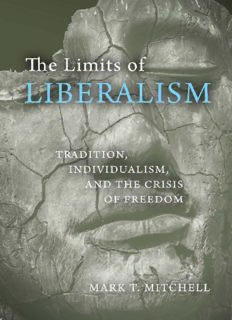
The limits of liberalism : tradition, individualism, and the crisis of freedom PDF
Preview The limits of liberalism : tradition, individualism, and the crisis of freedom
The Limits of Liberalism The Limits of LIBERALISM TRADITION, INDIVIDUALISM, AND THE CRISIS OF FREEDOM MARK T. MITCHELL University of Notre Dame Press Notre Dame, Indiana University of Notre Dame Press Notre Dame, Indiana 46556 undpress.nd.edu Copyright © 2019 by University of Notre Dame All Rights Reserved Published in the United States of America Excerpts from Four Quartets by T. S. Eliot. Copyright 1936 by Houghton Mifflin Harcourt Publishing Company; Copyright © renewed 1964 by T. S. Eliot. Copyright 1941, 1942. T. S. Eliot; Copyright © renewed, 1969, 1970 by Esme Valerie Eliot. Reprinted by permission of Houghton Mifflin Harcourt Publishing Company. All rights reserved. Library of Congress Cataloging-in-Publication Data Names: Mitchell, Mark T., author. Title: The limits of liberalism : tradition, individualism, and the crisis of freedom / Mark T. Mitchell. Description: Notre Dame : University of Notre Dame Press, [2018] | Includes bibliographical references and index. | Identifiers: LCCN 2018043824 (print) | LCCN 2018048894 (ebook) | ISBN 9780268104313 (pdf) | ISBN 9780268104320 (epub) | ISBN 9780268104290 (hardback : alk. paper) | ISBN 0268104298 (hardback : alk. paper) Subjects: LCSH: Liberalism—Philosophy. | Political science—Philosophy. Classification: LCC JC574 (ebook) | LCC JC574 .M568 2018 (print) | DDC 320.51—dc23 LC record available at https://lccn.loc.gov/2018043824 ∞ This paper meets the requirements of ANSI/NISO Z39.48-1992 (Permanence of Paper) This e-Book was converted from the original source file by a third-party vendor. Readers who notice any formatting, textual, or readability issues are encouraged to contact the publisher at [email protected] To George W. Carey With Gratitude Requiescat in pace A culture survives principally . . . by the power of its institutions to bind and loose men in the conduct of their affairs with reasons that sink so deep into the self that they become commonly and implicitly understood—with that understanding of which explicit belief and precise knowledge of externals would show outwardly like the tip of an iceberg. —Philip Rieff Liberty lives in the context of order; and order, beneficial to liberty, is maintained by traditions of many sorts, some quite illiberal in their content. —Edward Shills Tradition is not the worship of ashes, but the preservation of fire. —sometimes attributed to Gustav Mahler CONTENTS Preface ix Acknowledgments xi Introduction: Surveying the Landscape 1 and Defining Terms ONE The Seventeenth-Century Denigration of 25 Tradition and a Nineteenth-Century Response TWO Michael Oakeshott and the Epistemic Role 58 of Tradition THREE Alasdair MacIntyre’s Tradition-Constituted 95 Inquiry FOUR Michael Polanyi and the Role of Tacit 134 Knowledge FIVE The Incoherence of Liberalism and the 199 Response of Tradition Afterword: A Conservatism Worth Conserving, 269 or Conservatism as Stewardship Notes 274 Bibliography 313 Index 322 PREFACE In July 2016, the British people voted to leave the European Union. In November of the same year, Donald Trump stunned many by defeating Hillary Clinton in the U.S. presidential election. In January 2017, Trump took office to the consternation of those who were convinced that the rhetoric of secure borders and America First trade policies were ideas rooted in a reactionary and long dead—or at least dying—past. In March 2017, Charles Murray, a scholar at the American Enterprise Institute, attempted to give a lecture at Middlebury College in Vermont. A crowd of protestors—mostly students (and some of their faculty insti- gators) of that august liberal arts institution—shouted him down, violently intimidated Murray and his host, Middlebury professor Allison Stanger (who was pushed to the ground and concussed trying to protect Murray as they made their way out of the building), and surrounded their car, pounding it and rocking it so that they had to creep away through the crowd to prevent injuring anyone.1 In July, a Google engineer named James Damore used the company’s internal discussion board to argue that Google’s culture had become an “echo chamber,” that dissent from, what Damore considered, a liberal bias was not allowed, and that perhaps the reason that there are fewer women programmers than men is not a result of inferior capabilities but a differ- ence of interests. Damore was accused of fomenting a hostile work envi- ronment and fired.2 In August, white nationalists, Klansmen, and others convened a march in Charlottesville, Virginia, ostensibly with the purpose of protest- ing the removal of a statue of Robert E. Lee. There was a counterprotest led by the so-called Antifa. Things turned violent. A woman was killed.3 These events are related. The intent of this book is to try to explain what’s going on. ix
